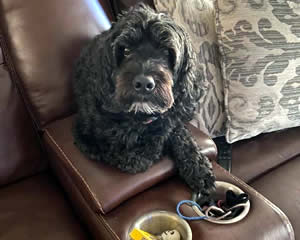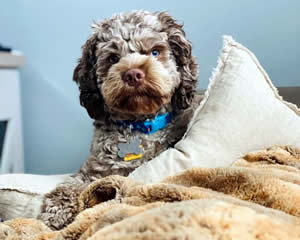



Hybrid vigor.......the possibility that one may obtain a better individual by combining the virtues of the parents,............
..........hybrid vigor occurs for specific disorders, and it can also occur in terms of general disease resistance.
Sets of genes control every characteristic of an organism. Each parent contributes one gene, called an allele, so a set consists of 2 genes, or 2 paired alleles. A dominant allele will cause that trait to show up even if only one copy is present. An allele that is recessive needs 2 copies in order for the trait to show up. For example, in humans, brown eyes are dominant, and blue eyes are recessive. If a person has an allele for brown and an allele for blue, they will have brown eyes. The dominant brown overrides the recessive blue. For a person to have blue eyes they need to have TWO copies of the allele for blue eyes. Notice in this example that carrying the recessive trait does not influence the physical result. The recessive gene’s presence is completely hidden.
A recessive trait, as you just learned, needs 2 copies in order for the trait to show up. If a dog carrying one recessive allele for some genetic disorder is bred to a dog also carrying one recessive allele for that disorder, some of the pups will get 2 copies and show the disorder. Those genes have become more ‘concentrated’ in the population. As one produces successive generations of a certain breed, trying to concentrate and ‘fix’ the traits that define the breed, other traits become concentrated and ‘fixed’ as well, those traits that cause genetic disorders. That’s why certain disorders are more common in some breeds than others. Nearly half of hereditary diseases found in dogs occur predominantly or exclusively in one or just a few breeds. If a dog carrying the recessive, defective allele is bred to a dog with ONLY normal versions of that allele, some pups will be carriers, but none will show the disorder. This is the basis of hybrid vigor.
Hybrid vigor is the phrase commonly used for what is correctly called heterosis. That is, the possibility that one may obtain a better individual by combining the virtues of the parents, by preventing the concentration of undesirable traits within the group. Individuals that are members of a population share genes, that’s what makes them members of that population! In the case of dogs, these different populations are different breeds, and those genes define every characteristic that makes a dog a recognizable member of that breed. It takes differences in only 10 to 30 genes to define one breed from the next. So will crossing two breeds result in a healthier animal? While the intentional breeding of known purebred dogs is considered a new practice, it is actually the continuation of the process by which all dog breeds were created, the process of selective breeding. Many argue that over the centuries, the process of purebred selective breeding of narrow lines of genetic variations in current dog breeds has produced un-health offspring where detrimental recessive genes have surfaced. This is especially true if the parent dogs were closely related. This inbreeding among purebreds has made many of the offspring susceptible to a variety of genetic health problems. With dog hybrids, new lines of genes are introduced with the hopeful effect of improving health as well as introducing desirable traits.
So hybrid vigor occurs for specific disorders, and it can also occur in terms of general disease resistance. There is a set of genes called the major histocompatibility complex (MHC) consisting of thousands of potential allelic combinations. The genes of the MHC are involved in controlling disease resistance, immune function, and reproduction. The long-term viability of any breed depends on maintaining a high degree of genetic diversity in the MHC. The loss of MHC genetic diversity is responsible for a portion of the reduced “hybrid vigor” in some breeds. These breeds are literally dying due to a lack of diversity in this complex, and researchers are working on the development of canine MHC genetic markers, so breeders can select and match these genes to maximize health.
In the last couple decades, several breeds have been in danger of being bred into oblivion due to the concentration of genes carrying genetic disorders. Breed clubs responded to this by doing what to some was absolutely heretical. They outcrossed with unrelated breeds. The AKC literally saved the Dalmatian from extinction (nobody wanted a breed of deaf dogs, regardless of other characteristics) by allowing breeding to non-Dalmatians. Similarly in Europe, Dutch Shepherd Dogs were outcrossed with the Belgian Tervuren, and Bernese Mountain Dogs were crossed with Newfoundlands. The choice was made to save these breeds by taking advantage of the phenomenon of heterosis...hybrid vigor.... to strengthen them.
Hybrid vigor has been clearly shown to exist in everything from fruit flies to orchids to pigs to humans. That’s why there are laws against people intermarrying, and why certain families that DID intermarry, like the Russian czars, find disorders like hemophilia among their members. It doesn’t matter what you are breeding, by maximizing the number of different alleles in the gene pool, you minimize the chances that disease-causing genes will end up paired together in any individual. Therein lies the promise of heterosis, or hybrid vigor.
LOCATION
HOURS
Mon-Sat: 8:00am-8:00pm
Sun: Closed
** Visitation by Appointment Only
Copyright © Homestead Cockapoos. All Rights Reserved.